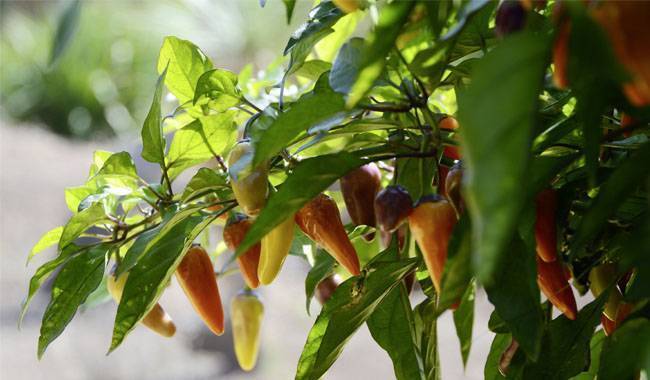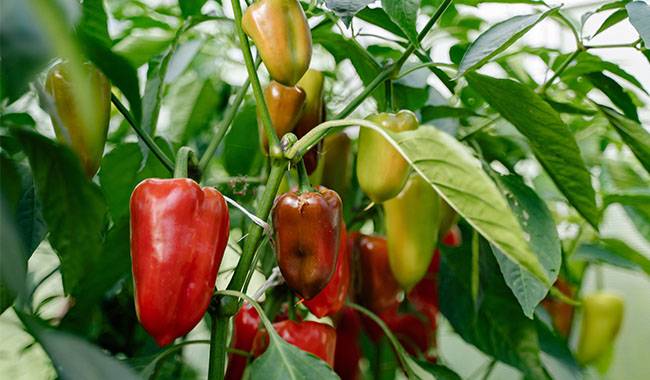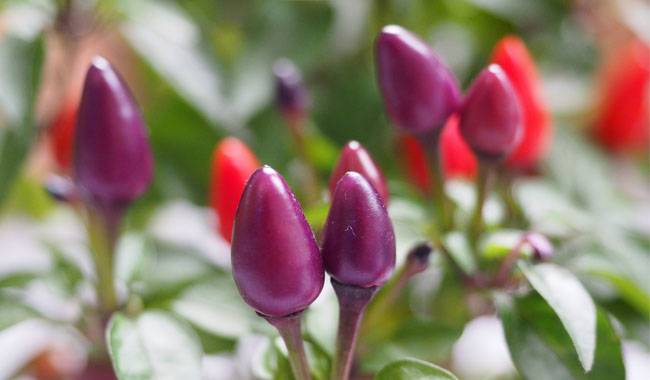
You want to extend the bright Ornamental peppers (Sweet And chili pepper) period indefinitely. And the fruit can be present on the plant for 6 months or more. However, if the start of fruiting cannot be accelerated without a supplemental lighting system, the completion of fruiting can be delayed for a long time. The vibrant colors of Ornamental peppers are a charming addition to fall interiors. In the winter, indoor peppers generally look like a colorful firework. Keeping them cool is the key to preserving them for months to come. But that’s not the only thing the plants need. You will learn how to grow Ornamental peppers in ThumbGarden’s article.
HOW TO GROW ORNAMENTAL PEPPERS INDOORS
The most common peppers to enter a room are miniature and compact plants. They are 6-31 inches (15-80 cm) tall and have a beautiful canopy of densely branched, shiny, dark, oval-shaped leaves that provide the perfect backdrop for scattered fruit.
Ornamental peppers are available almost year-round, but as fall approaches, you’ll find a particularly wide variety: peppers with round, elongated, interestingly curled, unusual and colored fruit are available for winter interiors.
Ornamental peppers combine all the varieties bred specifically for potted plants with miniature ornamental fruit. Among the ranks of potted peppers (Capsicum annuum) you can find edible, pungent “flames” and bell peppers, as well as pure Ornamental peppers hybrids with colorful fruit unsuitable for consumption. It is best to get information about their edibility before buying them. However, no matter which member of the Solanaceae family appears on your windowsill, it will require special care and attention.
HOW LONG DO ORNAMENTAL PEPPERS TAKE TO FLOWER AND PRODUCE FRUIT?
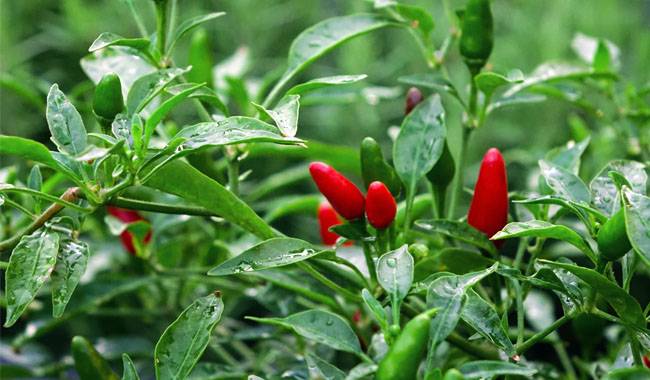
Once the fruits of Ornamental peppers dry up and fall off, the bushes are usually simply thrown away. However, extending their life indoors can be done for as long as possible – with continued attention and care. Peppers are predictable until they flower and fruit, reproducing asexually for 90-120 days before the “show” begins. However, once the fruit ripens, how long pepper can “last” depends entirely on its owner.
If the right conditions are not used, and the bush is not well cared for, peppers can dry out in weeks. But if well cared for, they can last for months – all the way into spring. The traditional “pepper” season lasts from September to January.
Nine major factors influence the timing of pepper fruiting.
- Lighting.
- Temperature regime.
- Stable conditions.
- Ventilation of the room.
- Humidity of the substrate.
- Air humidity.
- Plant nutrition.
- Timeliness of “harvesting”.
- Cleanliness of the plants.
Let’s try to figure out how to create the best conditions for the results of Ornamental peppers and what kind of ideal care to strive for.
GROWING CONDITIONS FOR ORNAMENTAL PEPPERS
Peppers look so beautiful during fruiting that you’ll want to admire their multi-colored crowns indefinitely. But don’t be fooled – while they are destined for tables, drawers, and coffee tables, they are best placed on a windowsill or near a southern, southwestern, or southeastern window (with plenty of light).
If the weather is gloomy in the fall and winter, you can’t get away from the extra light or move them to a southern windowsill. After all, a lack of light will cause the fruit to fall off faster.
Ornamental peppers are similar in many ways to other indoor fruit-bearing plants grown as annuals – the cooler the temperature, the better they are protected from heat, and the longer they retain their fruit. “Confuse” them with roses, but the optimum temperature for maximizing fruit set is between 59-68 °F (15-20°C). Even with the measures taken, heat will shorten the shelf life of peppers.
But brightly colored fruits, in particular, do not like large fluctuations as well as the effects of batteries and air conditioning. An exception to this rule is the Sweet And chili pepper, which is sometimes equated with the common inedible Ornamental pepper in terms of its role in the interior. They are more thermophilic, cannot tolerate temperatures below 60 °F (16°C), and prefer to be kept in a stable heat source with daytime temperatures above 75 °F (24 °C).
The difference in temperature between day and night will not harm any pepper. And if the difference is 40 °F (4°C) or more, peppers will keep for a few more weeks.
Peppers need to have free-flowing air and air circulation around the bush. They should not be pushed up against walls or other plants. Ventilating the room daily, leaving the windows open continuously in the summer, or bringing them into the fresh air will increase the amount of fruit and make them last longer. If shrubs are kept outdoors, they will be stronger, more vigorous, and will have more flowers, surprisingly.
But drafts can cause fruit to fall off more quickly. If you protect your plants from cold drafts and sudden turns, you can enjoy the beauty of scattered peppers for longer.
WATER AND NUTRITION OF ORNAMENTAL PEPPERS DURING THE FRUITING PERIOD
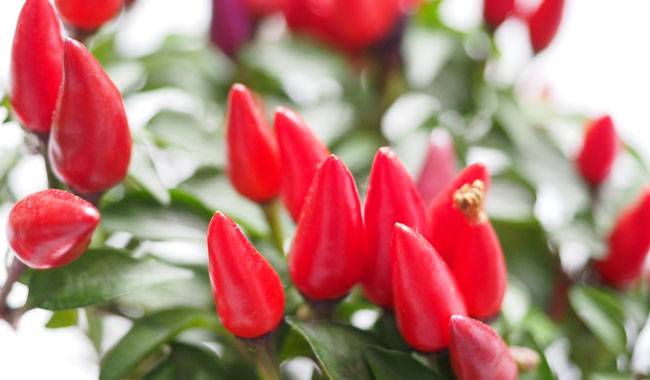
The stability of Ornamental peppers should be kept at everything. And watering is the first factor that helps to maximize and shorten the fruiting period. Overwatering and complete drying of the substrate are two extremes that can rapidly dry colorful Ornamental peppers. However, to preserve the fruit for as long as possible, a constant, light humidity, with a dry top substrate and no water in the trays (which should be emptied immediately) will keep the fruit for as long as possible.
Suppose there is any doubt about the permeability of the soil. In that case, it can be gently loosened periodically to prevent compaction, which is true for both sweet and hot pepper varieties for ornamental purposes. Or you can use the mulching method.
A steady “average” air humidity of 50-75% will ensure that the fruit stays in the bush for as long as possible. Too dry air and high humidity are equally dangerous for Ornamental peppers. Comfortable, constant conditions are usually easy to maintain with careful daily spraying (the sprayer should not leave any droplets but should form a cloud or mist). Peppers do not tolerate wet flowers and buds and only fruit in cool conditions.
Over-fertilization of peppers on the windowsill is even more dangerous than a shortage. Since Ornamental peppers are thrown away after fruiting, they can be left unfertilized. However, fertilization usually results in more abundant flowering and fruiting from the beginning of the active canopy to mid-fruiting.
Edible peppers and bell peppers should be fertilized frequently, once a week with a reduced dose of fertilizer, or every 3-4 weeks with a full dose of fertilizer. Once no new flowers are formed, fertilization should be reduced or even stopped altogether.
For Ornamental peppers, it is best to use a fertilizer specifically for fruit plants. However, if you are growing edible peppers, including Capsicum, you should pay more attention to their composition, preferably with organic or biological fertilizers.
Don’t forget that only healthy plants can bloom, bear fruit, and stay happy for a long time. You should pay attention not only to the state of the leaves and shoots to see the first signs of pests and diseases (which are quite rare in peppers). The main purpose is to detect conditions that need to be corrected and the first signs that the fruit on plants that are still in bloom are not yet fully ripe. This is one of the most invisible causes of rapid “drying” of the fruit.
The fruit should be “harvested” for bell peppers before they are fully ripe and not allowed to color; for chili and Ornamental peppers, as long as the pepper is flowering and a new ovary has formed on them, it should not be allowed to start shriveling.




